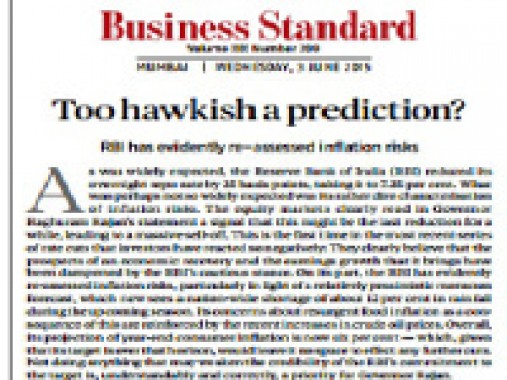What? Speaking in unison?
You don’t say!
Darius Nakhoonwala
It is not often that edits in almost all the papers say the same thing. But it does happen from time to time. The very boring monetary policy statement of the Reserve Bank of India on June 2 provides a case in point.
The RBI Governor, Raghuram Rajan, who by now must have understood what it means when they say be careful what you wish for, made two broad points in his speech. One, that inflation was still a problem and two, the banks were behaving very badly by not lending money to those who asked for it.
With the exception of the Business Standard and the Telegraph, all the others focused on this grievance. No one bothered to give the banks’ point of view which is that loans are not there for the asking but must be given on merit, especially now that so many of them are not being returned.
The Economic Times grumbled that “the Reserve Bank of India (RBI) has reduced its key policy rate by 25 basis points, its third such move this calendar year, but there is no guarantee that banks will actually pass on the rate cut to borrowers.”
It went on to say “the plain fact is that commercial banks, especially state-owned ones, find themselves cash-strapped with monies sunk into umpteen non-performing assets… until this issue… is resolved...the economy cannot regain growth momentum. And the task of organising this change falls to the government, not the central bank.”
The Business Standard said the Governor “expressed some satisfaction about seeing the previous cuts now being passed on. However, there are questions about whether this process is sustainable...” It then explained and gave a sharp rap on the delicate Rajan knuckle: “The RBI's unwillingness to ease constraints on liquidity through reductions in the cash reserve ratio (CRR) and the statutory liquidity ratio (SLR) also points to a certain hawkishness and constrained transmission. For now, the RBI seems to have decided to stop playing the game and sit on the bench.”
Mint, unusually, made some incomprehensible points before echoing the general view. “The ball is now squarely in the government’s court to create the conditions for the economy to embark on a non-inflationary recovery. As supply catches up, it may open up more space for the RBI to lower rates in the medium term. But for now, we think the RBI’s job is done.”
The Hindu Business Line said much the same thing. “The RBI has once again exhorted banks to hurry up with their transmission of lower policy rates to borrowers. After dragging their feet until March, more banks have trimmed base rates. But the transmission of the 75 basis point reduction in policy rates remains incomplete…With profits under pressure and capital in short supply, public sector banks may well choose to retain their high lending rates and protect their margins, rather than try too hard to woo new borrowers.”
The Financial Express focused on how the stock market reacted. “…far from boosting market sentiment, it gave them a serious fright and markets ended the day 661 points lower and bond yields 8 bps higher - it is difficult, though, to separate the impact of the RBI’s guidance and the Met’s forecast that projected a 12% deficient monsoon.”
The general papers were not much different. The Indian Express said: “The reason the markets tanked was probably not so much that the rate cut announced was half of what was widely wished for but because of the diminished likelihood of further cuts…Upside risks to inflation, via increased food prices, reduce the room for rate cuts down the line.”
The Telegraph said: “The government does not seem to understand the RBI's objectives clearly. The signals are, therefore, not clear enough for markets to pursue their own growth strategies.”
The Hindu had this explanation: “The RBI appears to have given banks a fresh message. Given the level of bad loans in their books, and also considering the stress on their margins, the banks will now have to do a tough balancing act. The RBI has only limited width to go beyond taking a measured step.” Duh?
The Times of India pointed to the “the limits of monetary policy…Raghuram Rajan does not have the firepower to propel the economy. It’s up to the NDA government with its emphasis on a public investment led economic revival to do the heavy lifting… The fallout of bad loans is a drag on the economy…At this point the deadlock can only be broken by good government policy.”
Such articles are only possible because of your support. Help the Hoot. The Hoot is an independent initiative of the Media Foundation and requires funds for independent media monitoring. Please support us. Every rupee helps.
